![]()
| Egypt | Aswan | 2001.05.12 - 05.18 |
South Egypt
The southern city of Aswan is an excellent base from which to visit Abu Simbel and the Temple of Philae and arrange a multi-day felucca ride on the Nile River.
GETTING THERE
Transport from Dahab to Aswan takes a full day by any method short of
flying. The cheapest yet less direct route is by bus from Dahab to Luxor
via Suez (E£ 90) and another bus from Luxor to Aswan (E£ 9).
The daily bus to Luxor leaves Dahab City at 16:00 and arrives the next
morning at 08:00. From Luxor, a 09:30 bus reaches Aswan 4 hours later.
Abu Simbel
Carved into the hillside of the Nile between 1290-1224 B.C., Pharaoh Ramses II designed Abu Simbel with four enormous status of himself to display strength to anybody sailing up the Nile from the south. Until 3 months ago, the road to Abu Simbel had been closed under orders by the Egyptian government. Today, vehicles can cross in convoy with police escort. The journey takes 4½ hours each way.
The cheap hotels in Aswan have day tours to Abu Simbel for the same price as roundtrip bus fare (E£ 20 each way). The advantage to going with the hotel is early morning departure to avoid the afternoon heat at the site. Hotel tours to Abu Simbel are E£ 40, depart at 04:00, and return by 13:30. Tours to Abu Simbel and the Temple of Philae cost E£ 50, depart at 04:00, and return by 15:30.
Admission into Abu Simbel is E£ 35 (E£ 19.50 with student card). The wall carving on the inside are as impressive as the statues of Ramses II on the outside terrace. Adjacent to Abu Simbel is the Temple of Hathor. There is no additional charge to see this temple with admission to Abu Simbel.
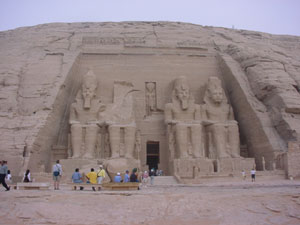 |
Four giant statues of Ramses II on the terrace of Abu Simbel intimidated boats coming into Egypt from the south up the Nile River. |
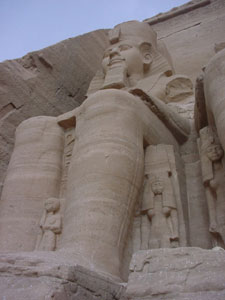 |
A close up of one of the Ramses II statues at the entrance to Abu Simbel. |
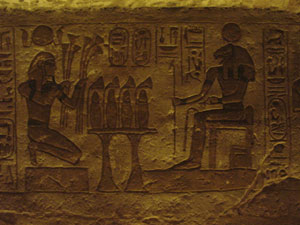 |
Inner wall carvings of Abu Simbel are as impressive at the enormous statues on the front terrace. |
Temple of Philae
About 10 km south of Aswan is the Temple of Philae. Once located on the submerged Philae Island, UNESCO moved it to neighboring Agilika Island with the completion of the High Dam of Lake Nasser that elevated the water level by 20 meters. Within Philae are several smaller temples, each with hieroglyphic inscriptions and carvings of ancient Egyptian gods. Admission in E£ 20 (E£ 10 with student card) excluding boat fare to Agilika Island.
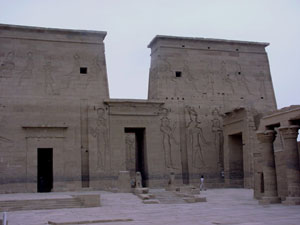 |
The Temple of Philae was submerged with the completion of the High Dam on the man-made lake of Nasser. |
Sailing on the Nile
In Aswan, a felucca can be hired for 2~4 days for a sailboat trip up the Nile to Edfu, a town halfway between Aswan and Luxor. The duration of travel determines the number of stops along the way.
It's impossible to escape men selling felucca rides in Aswan. A stroll down the street attracts solicitations from all directions. Finding a reliable captain, however, takes hours of interviews, boat inspection, and guest book reading. The Lonely Planet guide recommends talking to Shukri Saad at the Aswan tourist information office for names of reliable captains. We followed this advice.
Having talked to 5 felucca captains, we decided to hire Captain Zak of the felucca named Washington for a 3½ day / 3 night trip. Although feluccas normally carry 6-10 passengers, smaller groups can charter a boat for more money per person. We were a group of 5 traveling together since arriving in Egypt: Wes, Masami, Ryan, and Stephanie and Eric from Montreal. The price was agreed at E£ 90 per person for the full trip with meals. We were responsible for our own drinks and water. The next morning we set sail at 09:30.
Over the course of 3 days on the felucca, we visited a Nubian village where about 100 children ask tourists for pens, candy, and money (ugh!), a camel market, the Temple of Kom Ombo, and by sheer chance, a Nubian wedding celebration.
The camel market is open daily but hardly worth viewing except on Sunday when it's livelier. The day we visited, several dozen heavily branded camels stood in the sun with a front leg tied to prevent escape. Zero purchasers showed up.
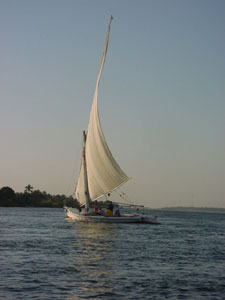 |
A felucca on the Nile. |
Temple of Kom Ombo
Dedicated to Sobek, the local crocodile-headed god, and Haroeris, the falcon-headed sky god, the Temple of Kom Ombo sits on the bank of the Nile where in ancient times crocodiles basked in the sun. Near the entrance is a room with a mummified crocodile. In the outer courtyard are pillars with colored hieroglyphics. Admission is E£ 10 (E£ 5 with student card).
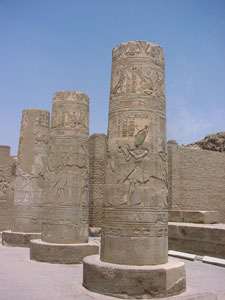 |
Color remains on inscriptions on the pillars of the Temple of Kom Ombo. |
Nubian Wedding
Two cousins of Captain Zak were getting married on the same day. Since we were riding his felucca and Zak wanted to attend, he invited us along. At 16:00, we landed the felucca on the bank of the Nile near the house being prepared for the wedding celebration. Men are required to wear galabeyyas, one-piece ankle-length robes. Women must be covered everywhere below the wrist and chin, and the head must be covered with a scarf. Wes borrowed a galabeyya and Masami borrowed a headscarf for the event.
A Nubian wedding celebration lasts 2 nights to one week. We attended the first night. Extended family members came from all parts of Egypt, some as far as Cairo 14 hours away. Since Egyptian men can have 4 wives, the family number is in the hundreds. Everyone in every village within a 50km radius seems to be related in one way or another. People continued to arrive by boat and pickup truck between early afternoon and one in the morning when the official festivities began. Benches, sitting mats, powerful lights, a sound system, a band playing twangy Middle Eastern music, and video crew were arranged on an open sandy patch outside the house. Men and women were segregated; the men seated directly in front of the celebration and the women off to the side.
A dozen men danced in unison to the right. From behind them the first groom entered the courtyard. This part of the ceremony lasted about 30 minutes. Then from the left, the first bride entered with a glittery yellow dress. 20 or so girls and women stood up to dance around the entering bride. In the center of the courtyard, the bride and groom were joined. At two in the morning, the process was repeated with the second groom and bride. No longer able to stay awake, at 02:30, we returned to the felucca for some sleep. The next morning, Captain Zak and his assistant "Magic" struggled to rise and set sail. They had both smoked too much marijuana and drank too much hard liquor early into the morning. 8 hours later, we docked for our last overnight on the felucca.
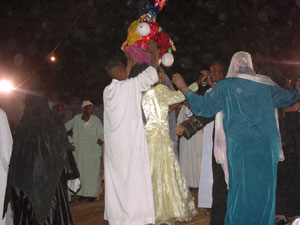 |
The bride in yellow is surrounded by other dancing women at a Nubian wedding celebration. |
Going to Luxor
The following morning, a minibus met us to take us the remainder of the way to Luxor. Wes woke up with a disorienting virus that affected others in our party a week ago in Dahab. Feeling completely off balance, Wes had to be supported by 2 people to walk the 100 meters from the felucca to the minibus. En route to Luxor, the bus stopped at the Temple of Horus. While Masami enjoyed the visit, Wes sat in a nearby cafe trying not to pass out.
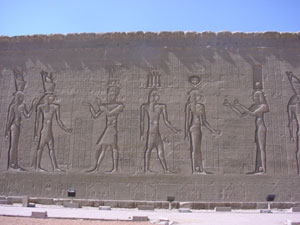 |
The exterior wall of the Temple of Horus has large intact carvings. |
Copyright © 2000-2002 Wes and Masami Heiser. All rights reserved.